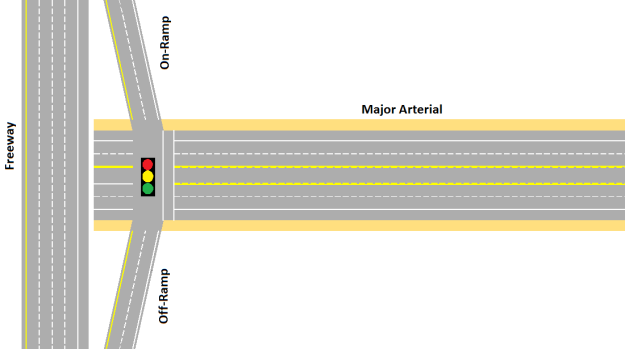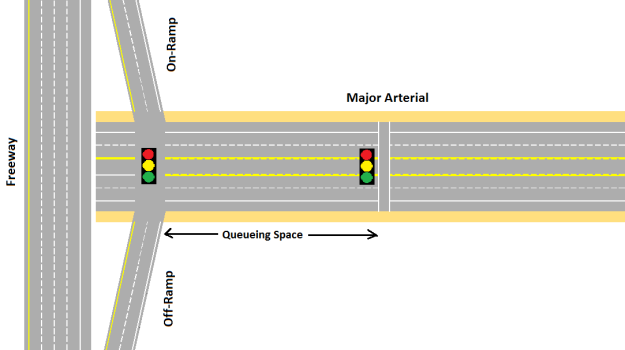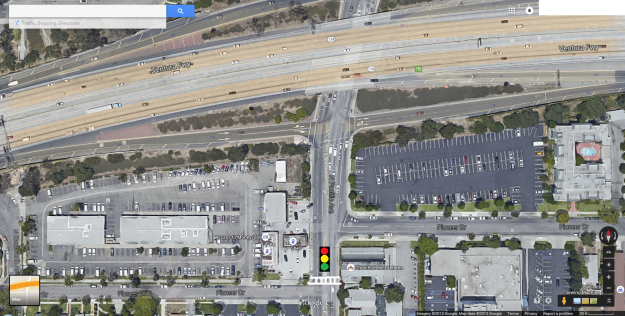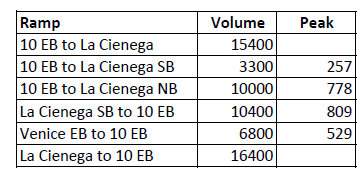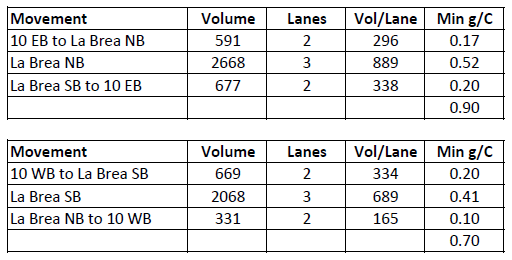The current conventional wisdom in urban planning is that freeways are bad. As a result, the usual response to any plan to build a new freeway or widen an existing one is to throw the book at it, and hope something sticks. This is straight out of the NIMBY playbook, and if you have enough money and good lawyers, you can usually find some technicality that will at least delay the project and force the proponents to pretend that they like to waste their money on “mitigation”. These arguments don’t have to be logically consistent, they just have to work. For example, you can argue that the new freeway lanes will be filled with cars before you know it, and that the new freeway lanes will go unused. Take your pick.
Engineers, though, we’re pretty agnostic. You go to school to learn how to design railroads, and in calculus, you sit next to someone going to school to learn how to help the CIA blow up railroads with unmanned drones. Whatevs. And that’s how it should be. You don’t want the police selectively deciding what laws they’re gonna enforce and who’s gonna be on the receiving end of that enforcement based on their personal opinions. And you don’t want your engineers to do a crappy job on your track design because they have a philosophical disagreement with streetcars. By the time things reach the engineers, all the relevant planning decisions have already been made. Even if I think your project is a bad idea, I’m gonna give you the best damn design possible.
When I look at things at a planning level, I try to bring that same sense of doing things efficiently. When I get upset about a freeway project, it’s not because it’s a freeway per se, but because (a) it’s in a place where there’s no need for any new transpo or (b) there would be a better way of meeting the travel demand. There are lots of bad freeway projects in the US, that are a waste of money and resources because they’re not very efficient. The planning level is the right level at which to stop these projects. So with that in mind, here’s an engineer’s assessment of the quality of planning level arguments against new freeway capacity.
No Demand
An easy one to forget, but like the do-nothing alternative, sometimes it’s the best. If there’s no demand for the facility, there’s obviously no point in building it. Since there is usually pent-up travel demand in cities, this argument is best applied to the pointlessly proliferating pork barrel rural freeways like the I-99 and the I-69.
Induced Demand
If anything, this is an argument in favor of new freeway capacity. Induced demand, as Kurumi whimsically put it, is the tragedy of a highway, once built, being used as intended. When urban planners talk about induced demand, they always do so as if it were some evil willed into existence by the freeway – like the additional people and goods moving around are just out there for the hell of it. But that additional traffic represents people who were able to move to the city for a better job, businesses that were able to reach more customers, friends who were able to head across town to meet for dinner.
Put another way, let’s say that we decrease the peak period headways on the Blue Line from 6 minutes to 4 minutes, and in a couple years, all the new trains are just as full as the existing trains today. Would anyone make the argument that the project was a failure because the trains are just as crowded? Of course not.
Increased traffic volumes do result in an increase in negative externalities like air pollution. The proper course of action is to appropriately price the negative externalities of driving. Indeed, if externalities were appropriately priced, the apparent need for many freeway projects would vanish. Controlling them by restricting capacity is like controlling people’s sewage output by not installing a larger pipe. It might work, but it’s not pretty.
Declining VMT
Now we’re getting somewhere. In the past, traffic predictions were usually too low. Today, they seem to be too high. If you’re reading this, odds are there’s no need for me to go into too much detail, but per capita vehicle-miles traveled (VMT) has been declining since 2004. This is due to a combination of the Baby Boomers aging (old people drive less), young people wanting to drive less, a significant increase in the price and price volatility of gasoline, stricter licensing laws, and the general economic malaise of the last decade. The relative importance of each of those factors is determined, of course, by the writer’s preexisting bias.
Declining per capita VMT can be a pretty solid argument against increasing freeway capacity, but it depends on the rate of population growth in your region. Let’s say that per capita VMT is declining at 1% per year. If you’re Houston, and your population is growing at 2.2% per year, the total VMT in your region is still going to up. Empty capacity in Cleveland doesn’t do you any good. Now, you could argue that something else would be a better transportation alternative than a freeway to meet that demand, but that’s a different argument, discussed in more detail later.
On the other hand, what if you’re Cleveland or Buffalo or Detroit, or any city that has lost population in the core while growth in the region has been anemic, if that? Well, you might want to reconsider expanding your roads. It’s hard to imagine that any of those three cities needs a major roadway expansion project. You have to wonder what MDOT is thinking when they write an EIR for widening the I-94 that says the city might lose residents due to the negative externalities of the wider freeway, but that they can be replaced with more commerce. Really, Detroit is lacking vacant land for commerce?
So declining per capita VMT might be a good argument; it depends on the city.
Parking Capacity
This starts to get into network effects, which are naturally more difficult to understand and model, and therefore more readily ignored. You could say that you don’t want to make it easier for people to drive to a destination because it will make the parking situation worse. Parking capacity is nominally easy to fix by building structured parking, and at some point, people will just stop driving to the place if they expect parking to be exceedingly difficult to find. This isn’t really an argument against building new freeway capacity so much as an argument for better parking policies, which is a separate issue. I think some guy named Donald Shoup wrote a book about that.
Local Street Capacity
Insufficient local street capacity is a great argument against building new freeway capacity. Local street capacity is limited by the available ROW, the need to provide space for competing uses like sidewalks, bike lanes, and street parking, and the need to split green time between conflicting movements at traffic signals.
Jarrett Walker likes to say that one of the best arguments for transit is geometry, because no technology can repeal its laws. Likewise, an important feature of the local street capacity constraint is that geometry makes it very difficult to resolve. Ultimately, and fairly quickly, you run into the need to do things like grade separate intersections and widen ROWs – things that are very expensive and unpopular, to say nothing of ruining the attributes that made the destination attractive in the first place.
A classic example of this is the 10 freeway in Santa Monica. There is a lot of congestion going westbound in the morning, starting at the off-ramp to Cloverfield and 26th and building back from there. The two-lane off-ramp queues back onto the highway, and before long, it’s curtains for all the westbound lanes and the ramps from the 405 too. The issue here is that the local streets in that area are saturated. It would be pointless, perhaps even counterproductive, to widen the 10, because it might make the situation on the local streets worse, and there’s no room to expand those streets.
Local street capacity in Long Beach is popping up as a reason to not widen the 405 in Orange County, and it’s a great argument. (Contrast this with the congestion on the 10 east at the junction with the 110, where the primary issue seems to be insufficient weaving distance on the 110 at the downtown exit and the 101.)
Better Transportation Alternative
As an engineer, this is pretty much living the dream. Nothing makes an engineer more content than coming up with a more efficient way to do things. And happily, there are a lot of ways to come up with a better transportation alternative. It could be a transit option. It could be fixing bad parking policies. It could be something that costs less. It could be just making more efficient use of existing infrastructure through things like improving signal timings and ramp metering.
This is the reason that all good engineers should love bike infrastructure. Even if you don’t think biking is fun, even if you ignore the health benefits, even if you think the political left is using it as a pretext to turn ‘Murica into China or Europe, in your cold engineer’s heart, you have to accept that biking is a very efficient way to serve mid-distance trips that are too far for walking, but not long enough to capitalize on the advantages of cars or transit. The advantages of cars and transit increase as the length of the trip increases, but the disadvantages are relatively fixed access problems, e.g. getting to/from the transit station or parking and getting to/from the arterials and freeways.
Los Angeles, coincidentally, is a city with huge bike potential. The pattern of development and density in LA naturally lends itself to trips of that length, and the street grid makes it easy to provide the infrastructure.
Case Study: Expo Line
Let’s take a look at an LA case study: the Expo Line, as compared with the option to widen a competing freeway, the 10, between Downtown LA and Santa Monica.
Note that right away, we can see that induced demand is no good. You’re fooling yourself if you think auto travel on the 10 and transit trips on the Expo Line are zero-sum. We’re certainly hoping that the Expo Line is going to induce some demand! Declining VMT is probably not a good argument here either. The LA area keeps growing, traffic on the 10 is already terrible, and the Westside in particular would be gaining population quickly if we’d get rid of the foolish zoning that prevents it from happening.
Parking capacity is a pretty good argument in Santa Monica and Downtown LA. As much as people in Palms and Culver City might complain, the parking situation there is actually pretty liquid. As surface parking lots and low-rise buildings in Santa Monica and Downtown LA are converted to mid-rise buildings, hotels, and high-rises by market demand, the cost of building parking spaces goes way up, because a structure parking spot costs about ten times what a surface spot does. If parking is unbundled and parking minimums are eliminated, many trips to or from these locations will naturally gravitate to transit, which is a more efficient way of serving those trips. This also makes a greater variety of land uses viable, and that’s a good thing. Finally, Carter Rubin would tell us that building more structured parking in Santa Monica will have a negative effect on the economic productivity of the area.
Local street capacity is a really good argument in both Santa Monica and Downtown LA, because in both places, the local street network is saturated during peak periods. In downtown, some of this is spillover congestion from the gridlock on the 110 and the 101. In Santa Monica, the aforementioned congestion on Cloverfield, as well as the greater 3rd St area (Ocean to Lincoln, Pico to Wilshire), seems to me to be almost entirely a function of local streets being maxed out. Expo Line allows for growth to continue in both neighborhoods without the need to undertake expensive highway projects. Palms and Culver City local streets aren’t terrible, though downtown Culver City can be bad at times.
Right in line with parking capacity and local street capacity constraints, we can see that the Expo Line is a better transportation alternative than widening the 10. A new lane on the 10 would have a capacity of about 2,300 veh/hr, or at an occupancy of 1.5 pax/veh, 3,450 pax/hr. The Expo Line, running 6 minute headways, has a capacity of about 10 train x 3 veh/train x 100 pax/veh = 3,000 pax/hr. The difference is, the congestion on the 10 is so bad, there’s no way it actually will carry that many people during peak periods. (Many people would argue that we could eliminate that issue with congestion pricing; while I’m in favor of HOT lanes, I think the idea of tolling all freeway lanes is impractical – an issue I’ll take up another time.)
Since Expo Line and the 10 don’t follow exactly the same corridor, there’s the benefit of providing better transportation to parts of the city that wouldn’t benefit as much from the 10 project. It lets trips on the Expo Line corridor avoid traveling north-south to the 10. That spreads the transportation wealth, since people near the 10 already have a high-quality transportation facility. (Some people don’t like living near a freeway, but hop on Westside Rentals and see how many listings say “convenient to the 405”.)
In terms of cost, Expo Line is probably a winner too. Widening the 405 by one lane between the 10 and the 101, about 10 miles, is costing over $1b. The project to add four lanes to the 5 between the 605 and Artesia, about 7 miles, is $1.6b but doesn’t involve the amount of retaining walls of the 405 project or a potential project on the 10, though it likely needs more ROW. Adding two lanes to the 10 between 4th St and Crenshaw, the logical limits and about 10 miles, would probably at least $2b. Add in the costs of additional parking and local street capacity in Santa Monica and downtown LA, and you’re in the neighborhood of the Expo Line’s $2.5b cost. The Expo Line will also make efficient use of available capacity elsewhere in the system (Gold Line and the forthcoming Regional Connector) that is not available to a project on the 10, since the 110 and the 101 are jacked.
Argue Smart
A victory on a technicality might feel great in the short run, but in the long run it’s Pyrrhic. The proponents of projects get wise and produce ever more voluminous studies. The same tactics can be used to stop good projects; pick your favorite transit project, and odds are it’s facing a bogus NIMBY lawsuit. Continued frustrations build a political movement to change the laws on environmental review (which, though I think it needs to be addressed, if done poorly could open the door for harmful projects). You can only win on technicalities for so long, as Expo Line opponents just found out.
Stick to the arguments above, though, and you’ll have a solid case every time. Laws can fix trivial details, but they can’t change the laws of logic, geometry, and efficiency.

